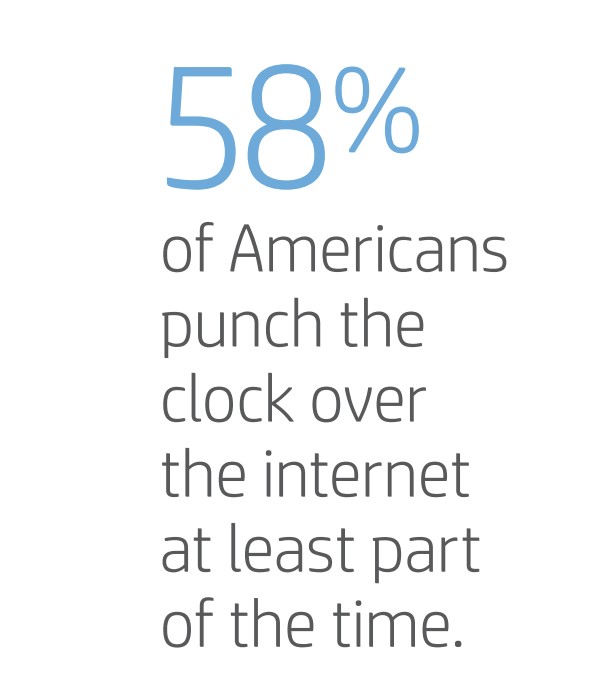Work has changed—with many good outcomes. But to ensure everyone gets the most benefit from the hybrid work model, IT needs to retune priorities.

Change can be gradual and incremental. But sometimes circumstances shift rapidly—such as the year 2020. Society has seen the most significant adjustments in work since the Industrial Revolution.
We began working longer and more disjointed hours, from all sorts of locations. We successfully used technology to hold everything together, with greater success than anyone could have predicted. Some of the post-pandemic changes were even welcomed. Now businesses are aiming to keep the best parts of the “new normal” as they move forward.
So how does our work life differ from the Before Times?
Flexible workplaces have become commonplace.
We went from working in open-plan offices to meeting in Zoom with cats walking on the keyboard. Prior to that, only one in five employees had occasionally worked from home.
In 2021, however, businesses began to pivot to a “hybrid” style of business, where employees have to put on hard pants only half the week. According to surveys, 58% of working Americans punch the clock over the internet at least part-time.
As an example of how dominant this hybrid style of work is expected to be, Google plans to have 60% of its staff work in the office a few days a week, and only one-fifth of the 140,000-person company will continue to work from home.
What that means for IT leadership: It’s up to IT to plan, deploy, manage, and secure the technology supporting people who might be working anywhere.

Some things stay the same, such as the way employees access IT systems through on-site policies and tools. In general, workers expect remote computing to match or exceed the inoffice experience—which requires more or different technology. Workers need collaboration tools and online applications, reliable connectivity even in offbeat locations, and security services that generate the same confidence as when they work in the office. However, employees absolutely expect better-quality coffee, because they got used to making it on their own espresso machine, accompanied by homemade sourdough.
All of that (except perhaps the coffee) means that corporate systems deployment for remote employees requires extra attention. That spells more pressure on the IT department to deliver, not less. IT has to make sure the organization’s data—and its customers’ data—can be accessed seamlessly by authorized users, in only a few clicks. And with more reliance on cloud computing, IT needs to recognize what could be automated—and what to leave in the real world.

More employees are satisfied with their jobs.
More than 60% of employees are as satisfied with their jobs as they were pre-pandemic. Those employees say their productivity has not changed, even with the upheaval of leaving the office and, perhaps, working in their closets. Even better, many workers are confident about what their supervisor expects of them, even though they’re no longer in the boss’s field of vision.
Perhaps some of this is because managers are having more meetings. At least those meetings are shorter and therefore take less time out of managers’ days.
Job satisfaction is at a twenty-year high, at 57%. Also, meetings are now shorter. Coincidence?
Best of all, 55% of employees feel that their management trusts them. The result? Employees who feel trusted are six times more likely to be engaged with and committed to their work.
What that means for IT leadership: More satisfied employees means less turnover—and that means employers need to ensure that working conditions and tech infrastructure support a hybrid work model. Short-term stopgaps need to be resolved to serve workers for the long haul. 
The IT department can contribute to employee contentment by ensuring that users’ computing experience stays at least as predictable as it used to be. Nobody wants to spend time struggling to make things work.
The hybrid work world adds new IT security challenges, because workers often use their own equipment. Cybercriminals have more opportunities, due to telework mistakes, virus-related phishing links, and out-of-date user security training—and they are exploiting those weaknesses. IT has to protect all those users.
With a distributed workforce, companies need to ramp up user support, whether someone’s workspace today is in a coffee shop, at the kitchen table, or in a conference room in the downtown office. (Cat on keyboard is optional.)
The more business changed, the more technology adapted—and will continue to do so
 In 2020, workplaces became virtual almost overnight. We acclimated to digital workflows, virtual collaboration, and limited access to printing for work.
In 2020, workplaces became virtual almost overnight. We acclimated to digital workflows, virtual collaboration, and limited access to printing for work.
Organizations learned that they can make huge changes, quickly, when they need to. How quickly? Even though businesses claimed it would take more than a year to establish work-from-home solutions, it actually took an average of only 11 days.
This remarkable feat presents a valuable lesson: Organizations can continue to make nimble changes in the future. Thus, post-pandemic work life will continue to see new technical innovations.
Because change is a constant, expected tech innovations throughout 2021 include increases in security and privacy response, remote operations, hyper-automation, and lightning-fast business decisions based on available data.
What that means for IT leadership: IT is now front and center. It plays a more strategic role in the organization, whether that means wholesale moves to cloud solutions, VPN deployments, or targeted solutions for interoffice communications. Business strategy depends on IT systems more than ever—and company leadership knows it.
Dare we say it? IT is finally getting the appreciation it deserves.

How has work life adapted?
Staid old companies that once resisted change actually pivoted quicker than you can say, “There’s no place like [working from] home.” Now that’s progress.
IT is impacting your business more than ever. But each new opportunity raises new technology challenges. Transformation projects are accelerating rapidly, which means that IT teams are under even more pressure.

